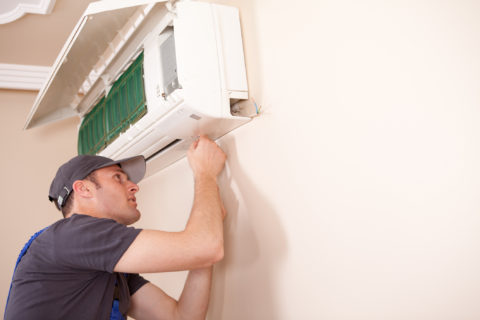The Importance of Indoor Air Quality
When you’re out in the world, you’re exposed to all sorts of air pollution, from auto emissions to factory smokestacks to fumes from whatever that road crew is doing to the road. It’s nice to get home, shut your doors, and take a nice, clean breath of healthy, wholesome indoor air, right? Not so fast. Did you know that indoor air can be as much as five times as polluted as indoor air? In fact, some airborne pollutants can be found indoors in quantities 100 times more intense than what you’d find outdoors. Poor indoor air quality can be extremely damaging to the health of the people in the building, so it’s important to know what causes indoor air pollution and how to improve your indoor air quality.
- What contributes to indoor air pollution? There are many different types of pollutants that can be found inside, including allergens like dust and pet dander, gases and volatile compounds being released by furniture and cleaners, particulates from cooking, excess moisture, smoke from tobacco products, and outdoor pollutants that get trapped indoors. It’s important to be aware of what’s in your air; buildings hang onto things brought in on shoes, pumped in by the HVAC system, and off-gassed by furnishings and building materials.
- How does indoor air quality affect people? Numerous studies indicate that poor air quality can lead to a wealth of issues for the people inhabiting or working in the building. Indoor air pollution can cause symptoms like eye, nose, and throat irritation, headaches, dizziness, and fatigue, and can even contribute to illnesses like respiratory diseases, heart disease, and even cancer. There’s even an ailment known as “sick building syndrome” that involves headaches, sore throat, and nausea associated with spending time in a particular building. What’s more, low-quality air can impede the productivity of workers, impair cognitive function, and lead to more absences and lower test scores for students.
- How do you know if you have indoor air quality issues? If you notice changes in your health after you move into a new house, buy new furniture, or do some remodeling, this could be a sign of a problem with your air. You should also be aware of potential sources of air pollution so that you can manage them if they’re in your home. Consider your lifestyle and activities, your home’s ventilation, the products you use in your house, and odors that could indicate a problem. You can also have the air in your house tested if you suspect you may be harboring pollutants. It’s recommended that you have your house tested for radon and install a carbon monoxide detector. You can also have your home tested for other pollutants like mold, though testing for many pollutants can get expensive. If you have reason to believe your home was built with materials like asbestos or formaldehyde, or you think you have a problem with mold, it might be worth the investment.
- What can be done to improve indoor air quality? Sometimes, it’s as simple as opening a window. Buildings that stay sealed up are more energy efficient but can create problems with indoor air quality. Improving ventilation and circulation can go a long way towards improving the air inside a building. In your home, there are several practical steps you can take to make your air cleaner:
- Keep your home clean to eliminate pollutants. Set up regular cleaning routines, vacuuming, dusting, cleaning bathrooms, and washing linens frequently. Change your HVAC filters regularly, and groom pets to reduce the amount of pet dander in your indoor air. You might also consider having your ducts cleaned if you feel they’re contributing to your poor indoor air quality.
- Watch which chemicals you’re introducing into your home. Steer clear of anything with heavy fragrances, including candles and air fresheners. Opt for natural cleaners instead of those that use harsh chemicals. Use natural methods of pest control instead of pesticides. Read labels carefully and make sure to follow the manufacturer’s instructions when using anything potentially hazardous. Dispose of unused or partially used containers of unneeded chemicals. Make sure to ventilate the area well if you’re using chemicals like paint or solvents.
- Take control of the moisture in your air. Keep the humidity level in your home below 50 percent; if you live somewhere humid, consider a dehumidifier. Fix leaks as soon as possible.
- Seal the source of pollutants. Keep your windows closed when pollen or outdoor air pollution is high. Adjust appliances like gas stoves to decrease their emissions.
- Clean the air in your home. Air purifiers can be helpful in removing pollutants from your air, and they’re available in every size from tabletop to whole-house models. A home ventilation system is another great option. With this kind of system, you can pull polluted, humid air out of your home, while pumping fresh, clean air in.
- What does indoor air quality have to do with basements and crawl spaces? Plenty! Basements are prone to moisture issues, and when there’s a problem with the basement air, it causes a problem with the air in the rest of the house. Crawl spaces can be particularly problematic because they’re often dirty, damp, and poorly ventilated. When contaminated air from your crawl space makes its way into your HVAC system, it pollutes the air inside your entire home. Waterproofing your basement or encapsulating your crawl space can make a big difference in your indoor air quality.
When you need basement or air quality services, Budget Waterproofing can help. In addition to waterproofing, mold remediation, mold cleaning, and crawl space encapsulation, we provide foundation repair, going beyond patching cracks to find the source of the problem. We also offer installation of the EZ Breathe home ventilation system, to clean the air inside your home. At Budget Waterproofing, we’ve got more than 55 years of experience servicing both commercial and residential customers throughout Maryland. We’re proud of our craftsmanship and confident in our skills, and all of our technicians are fully licensed and insured. Whether you need foundation repair, basement waterproofing, a drainage system, crawl space waterproofing, or egress window installation, we’ve got you covered, with the experience and skills necessary to improve your basement and protect your family. For more information, contact us today.


